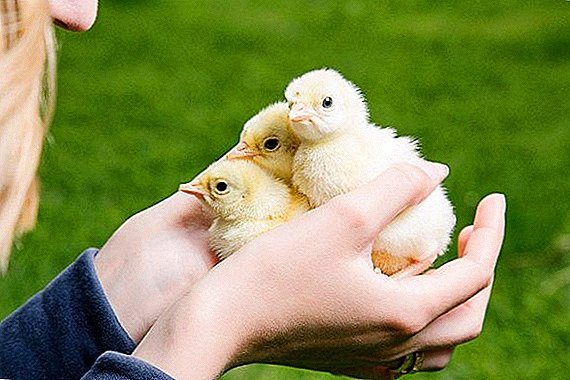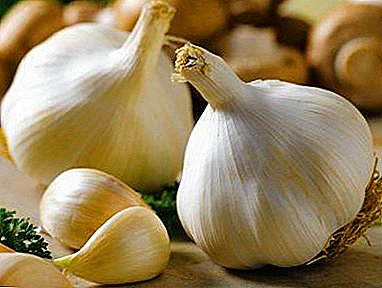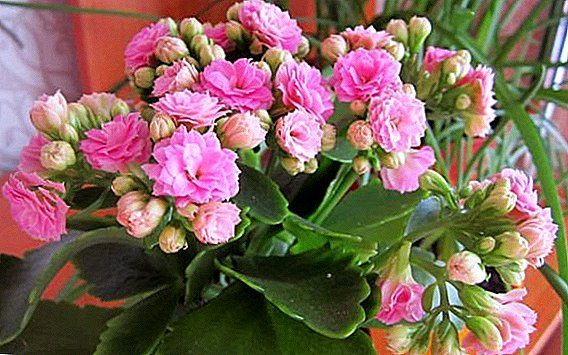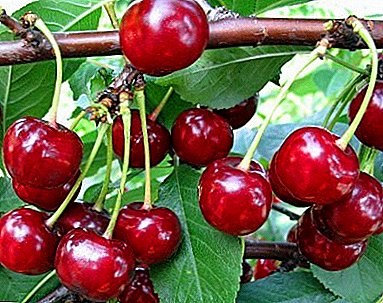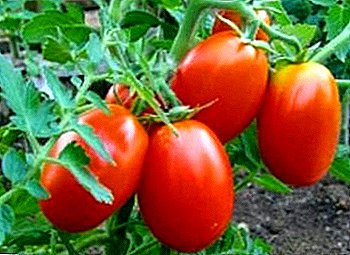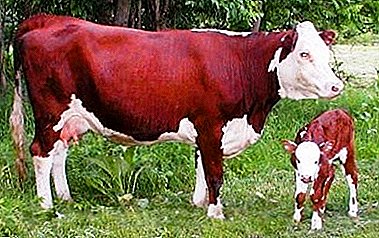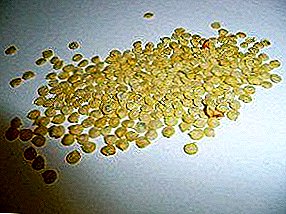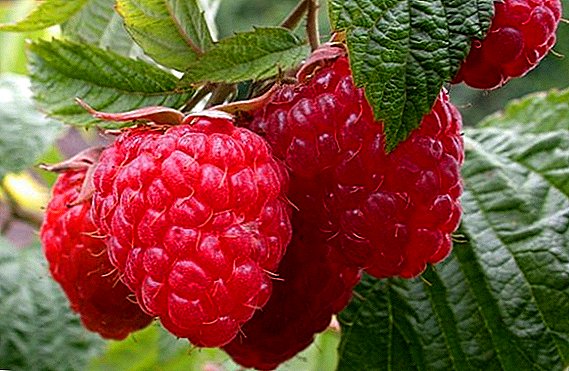 Raspberries - a berry with many positive properties and characteristic, well-remembered taste, for which he is loved by gardeners.
Raspberries - a berry with many positive properties and characteristic, well-remembered taste, for which he is loved by gardeners.
However, the yield of bushes due to the peculiarities of the biological structure sometimes leaves much to be desired. In order to overcome this problem, breeders have developed special raspberry varieties, called remontants, which are capable of producing crops several times in one season.
The article will discuss one of these raspberries - Zyugan, description of the variety, the yield from one bush, planting and caring for it.
Breeding history
The history of the selection of this raspberry variety begins in Switzerland, where local gardeners have conceived to bring out a variety that would be amenable to transportation and had attractive berries of heavy weight, while also possessing remontant properties.
Did you know? In the thieves' slang, "raspberries" is called a hangout in which criminals gather after committing their dark deeds. The similar image of a raspberry found the display in the well-known song "Murka".
Ultimately, Lubera succeeded in this by crossing such varieties as Terri-Louise and Joan Squre. At the moment, this raspberry variety is a leader in sales of seedlings by this organization.
Description and distinctive features of the variety
The characteristics of Zyugan raspberry are truly impressive, few of which domestic varieties are able to compete with this in yield, beauty and taste. In addition to the obvious benefits in the form of berries, you can also get additional benefits by starting to plant seedlings for sale, which is not so difficult to implement.
Bushes
The height of the bush is much higher than the average and can cross over 1.9 m. It has straight stems, rather thin, covered with a large number of small thorns and in some places with waxy substance.
Gives a very large number of shoots in the autumn. The bush is rather compact, it prefers to grow not to the sides, but upwards. 
Berries
In addition to the excellent taste, the berries of the Zyugan reparative raspberry also have very good transportability and keeping quality. When assembled, the fruit can be without visible changes for 4 days, and in refrigerators for at least a week.
Did you know? Due to the presence of fruit acids in raspberry fruit composition, it can be used as a substance that helps alleviate the hangover syndrome.
The shape of the berry is rounded and elongated, has a characteristic brilliance in the sun, the color - when fully ripe, is bright red, with a pronounced crimson hue. Drupe is very dense, why the fruit does not crumble.
The berry has a rather high resistance to heat, which is why it does not bake in the sun. The weight of the berry with all the rules of cultivation can reach 6-7 g.
Yield
This raspberry variety has a truly amazing yield, with a bush that has 7-10 shoots formed, for 2 crops per season it is possible to gather about 7-9 kg of berries from a single bush.  According to some gardeners, with scrupulous and proper care, this indicator can be increased to a result of 12 kg.
According to some gardeners, with scrupulous and proper care, this indicator can be increased to a result of 12 kg.
Disease resistance
It should be noted that absolutely all remontant raspberry varieties have increased resistance to various diseases and pests, however, in conditions of excessive humidity, there is a possibility that your bush will develop any of the fungal infections: purple spot, ventilla, septoria, anthracnose or wilt.
Check out such varieties of remontant raspberries such as Heritage, Hercules, Atlant, Gusar, Caramel, Polka, Yellow Giant.All these diseases can be cured by treating your shrub with a solution of a fungicide.
Winter hardiness
Zyugan's raspberry has a very well pronounced winter-hardiness, for which she fell in love with many gardeners from countries with a cold climate. These shrubs can withstand frost from -30 ° C to -35 ° C without much harm.
Especially well the bushes will help to survive the winter copious snow cover, which will act as a kind of covering material. 
How to choose seedlings when buying
When buying raspberry seedlings you should always keep in mind that the smaller its size, the greater the likelihood that it will successfully take root and develop correctly and quickly.
Seedlings with large shoots after planting will spend a very large amount of resources on the further growth of the stems, while the primary task for planting in the first year for raspberries is the development of the root system.
Important! When buying, special attention should be paid to the root system, which should have a large number of branches, be fibrous and have no more than 3-4 surface stalks.
Remember also that you should not make the purchase of seedlings in natural markets, since sellers very often do not monitor the varietal purity of their goods and place the roots of the seedlings in plastic bags, which may cause them to rot and in the future it will be bad or not to take root at all.
Chances are that even acquiring a viable seedling you will grow from it a normal game. 
Choosing the right place
A raspberry is a plant that does not tolerate the influence of various drafts, and even more of a squally wind, from which its berries begin to fall, so it is recommended to plant it in areas closed from the influence of a given factor, for example, under the walls of a building or fence.
Lighting
Zyugana requires a lot of sunlight, which has a beneficial effect on the processes of photosynthesis that take place inside the plant and contributes to the speedy development of seedlings and more active fruit ripening.
Therefore, it is necessary to plant it on a site that would be under the sun for as long as possible during the day.
The soil
For the cultivation of this raspberry variety is best suited soil containing a large number of nutrients, preferably with a weakly acidic structure.  It is categorically impossible to plant raspberries in the grounds where plants from the family of solanaceous and other raspberry varieties used to grow, since these plants emit specific substances that inhibit the development of the root system of the bushes of this plant.
It is categorically impossible to plant raspberries in the grounds where plants from the family of solanaceous and other raspberry varieties used to grow, since these plants emit specific substances that inhibit the development of the root system of the bushes of this plant.
Preparatory work
Before embarking on the planting process, you need to perform a number of simple measures designed to increase the likelihood of successful rooting of the plant and its further successful development.
First of all, it is necessary to carefully examine the root system for damage, and to eliminate all parts that have defects.
Then it is necessary to tear off all the leaves from the stems and cut them up to a length of 20-30 cm, after which the seedling is dipped into the mixture consisting of mullein and clay. You can also treat seedling rootstock with any growth promoter. 
Stepwise landing process
Zyugan's raspberry is not a little different from ordinary raspberry varieties in matters of planting and care, but some nuances are still present, which will be discussed further.
The approximate landing algorithm is as follows:
- First of all, it is necessary to prepare pits, the depth of which would reach 40-50 cm, and the length was 40x40 cm.
- At the bottom of the pit it is necessary to lay a mixture consisting of 2 parts of fertile soil, 1 part of peat or sand and 1 part of manure.
- From above, you need to make one glass of mineral fertilizers, preferably amofoski or nitroamofoski, you can also add a little potassium sulfur or a quarter cup of wood ash.
- After that, a sapling is placed in a pit so that the roots stretch well and do not bend over in any place, cover it with soil, periodically compacting the soil around it.
- Next, the planted plants are poured with water, approximately one bucket under each bush and mulch the soil with peat, mowed grass or hay.
Competent care - the key to a good harvest
Raspberry care requires some special knowledge and skills, the use of which will guarantee a rich and tasty harvest.
Watering and mulching
Raspberries need to be watered everyday, especially in the summer season, which should not be too abundant, as this can lead to root rotting and further plant death.
Important! If you do not have the opportunity to water your raspberries every day, try to establish a drip irrigation system that has proven itself to be quite effective and has been successfully used in our country for several decades.
You need to water in the evening or morning, one bucket of water under each bush. In order to reduce the frequency of irrigation, you can mulch the soil around the plant with hay, peat or freshly cut grass.
Weeding and loosening
In connection with the superficial location of the root system, loosening of the soil must be carried out with extreme care so as not to harm it. Loosening to a depth of more than 5 cm is not allowed.  Despite the possible harm from loosening, it is still a necessary procedure, as the rhizomes of the plant need an active supply of air to them. Weeding is best carried out in manual mode, while trying not to damage the roots.
Despite the possible harm from loosening, it is still a necessary procedure, as the rhizomes of the plant need an active supply of air to them. Weeding is best carried out in manual mode, while trying not to damage the roots.
Top dressing
Raspberry requires for the year making several heavy dressings. The first dressing should be in the spring, immediately after the snow has come down and should include urea. And in early September, the plant is fertilized with the help of various mineral substances.
In the summer, it is better to alternate between feeding with organic substances and mineral fertilizers. The best fertilizer for raspberries based on organic matter will be rotted manure, and among minerals superphosphate will serve the best service.
Trellis
Since the height of the raspberry variety is impressive enough, it is recommended to install a trellis next to the bushes - a lattice structure that serves to support the plant.
The simplest trellis consists of two pillars, between which an arbitrary amount of wires or twines are stretched, onto which the plants are fixed as they grow.  For this variety, it is recommended to install a double row trellis with a height of 1.7-2 m. The first wire is stretched at a height of 40-70 cm, and the second - 1.4-1.6 meters. The garter is obligatory, it will contribute to the maintenance of the branches, will help in their ordering, will facilitate the assembly work.
For this variety, it is recommended to install a double row trellis with a height of 1.7-2 m. The first wire is stretched at a height of 40-70 cm, and the second - 1.4-1.6 meters. The garter is obligatory, it will contribute to the maintenance of the branches, will help in their ordering, will facilitate the assembly work.
Pruning
Pruning should be carried out in the summer, after raspberry otplodonosit. Pruned the shoots that gave the crop. In the autumn period, the plant begins to give a large number of shoots that must be cut, because they will select the juice from the main shoot.
There are 8-12 shoots per formed bush. In the spring, it will be necessary to cut off all thin and young shoots, while respecting the basic rule about the number of shoots on an adult bush.
Shelter for the winter
Before the first frosts strike, it will be necessary to bend all the stems to the ground, sprinkle them with earth, or tie them to a peg.
Learn how to properly prepare raspberries for winter.If the winters in your region are rich in snow, then you should not worry about building additional shelter, but if the temperatures fall below -35 ° C, then you should additionally cover the bush with a thick covering material and try to roll it over well so that there are no gaps.
 We hope that the article helped you to come to an unequivocal opinion about whether you need to grow this sort of raspberry on your site. Remember that proper planting and scrupulous care are the main reasons for getting a rich and tasty harvest.
We hope that the article helped you to come to an unequivocal opinion about whether you need to grow this sort of raspberry on your site. Remember that proper planting and scrupulous care are the main reasons for getting a rich and tasty harvest.

